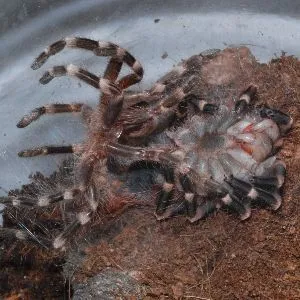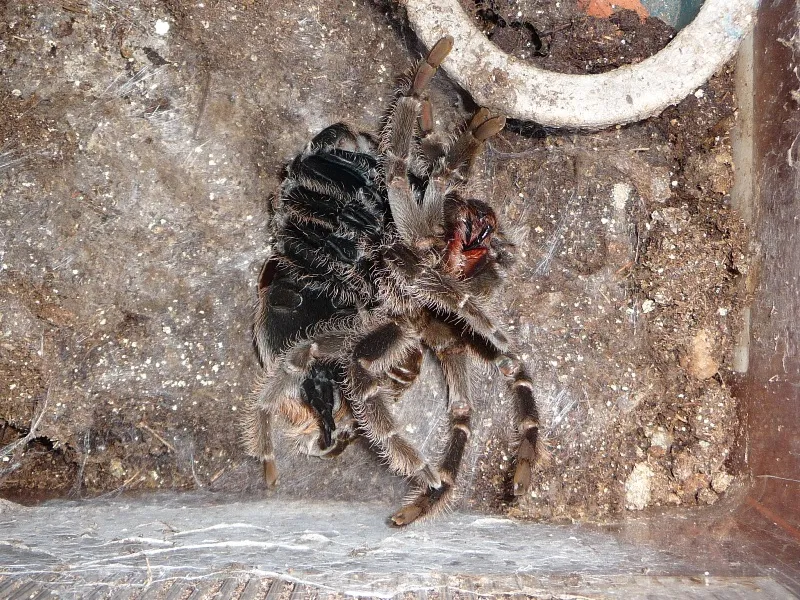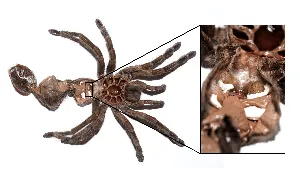What is Tarantula Molting
Tarantula molting, also known as ecdysis, is a natural and essential process for these fascinating arachnids. It’s essentially how tarantulas grow and shed their old exoskeleton, which doesn’t grow with them. This outer shell, made of chitin, becomes too small as the tarantula’s body expands. During molting, the tarantula creates a new, larger exoskeleton underneath the old one. This process not only allows the tarantula to grow but also replaces damaged or lost limbs and rejuvenates internal organs. Understanding molting is crucial for any tarantula owner, as it directly impacts the health and well-being of their pet. Successfully navigating each molt is a sign of a healthy and thriving tarantula, and proper care during this period can significantly improve its chances of survival and longevity. It is a fascinating process to witness, and knowing what to expect can reduce any stress you may experience during this period of change.
The Molting Process Explained
The molting process is a complex and energy-intensive undertaking for a tarantula. It begins with the formation of a new, soft exoskeleton beneath the old one. The tarantula then absorbs fluids, causing the old exoskeleton to split, usually along the carapace (the top of the cephalothorax) and the abdomen. The tarantula will then slowly work its way out of the old shell, leaving behind what appears to be a perfect, albeit empty, replica of itself. Once free, the tarantula is incredibly vulnerable, with its new exoskeleton being soft and pliable. This is why it’s so important to maintain a safe and undisturbed environment during and after molting. The tarantula will inflate its body with fluids to stretch the new exoskeleton, and over the following days and weeks, the exoskeleton hardens, and the tarantula regains its strength and color. The entire process, from pre-molt to hardening, can take anywhere from a few weeks to several months, depending on the tarantula’s age, size, and species.
Pre-Molting Signs to Watch For

Recognizing the signs that your tarantula is about to molt is crucial for providing the appropriate care. Several behavioral and physical changes can indicate an impending molt. Observing these signs allows you to prepare the enclosure and minimize any potential disruptions. These signs can vary slightly depending on the species and individual tarantula, but familiarity with them will greatly help you in caring for your pet tarantula. Being vigilant and attentive to your tarantula’s behavior is key to ensuring a successful molting process.
Behavioral Changes
One of the most common behavioral changes is a decrease or complete cessation of appetite. Your tarantula may refuse food for weeks or even months before molting. This is a natural response, as the tarantula conserves energy for the molting process. Additionally, you might notice your tarantula becoming more reclusive, spending more time in its burrow or hiding spot. They might also appear sluggish and less active than usual. Some tarantulas may seal off their burrow entrances with webbing, further isolating themselves. These behaviors are all indications that your tarantula is preparing for a molt and needs a calm, undisturbed environment.
Physical Changes
Physical changes are also key indicators. The most noticeable is often a darkening of the abdomen. This is due to the formation of the new exoskeleton underneath. You might also observe a change in the coloration of the fangs; they may appear lighter or duller as the new fangs develop. The tarantula’s abdomen may also appear swollen or distended. In addition, the tarantula may start to lose some of the hairs (urticating setae) from its abdomen, a natural part of the pre-molt process. Keep in mind that the time of year can also affect the molt period, and the process can be longer during the winter months.
Creating the Ideal Molting Environment

Providing the right environment is critical for a successful molt. This involves paying attention to temperature, humidity, substrate, and the overall safety of the enclosure. A well-prepared environment minimizes stress and helps the tarantula through the molting process with ease. The setup you have can greatly affect the molting process, and taking the time to prepare will greatly affect your tarantula’s health.
Temperature and Humidity
Maintaining the correct temperature and humidity levels is essential. The ideal temperature range generally falls between 75-85°F (24-29°C), depending on the species. Humidity levels should also be appropriate for your tarantula species. Too little humidity can cause the exoskeleton to dry out, making it difficult to molt, while too much can lead to health issues. Using a hygrometer to monitor humidity is highly recommended. You can adjust humidity by misting the enclosure, using a water dish, and ensuring proper ventilation to prevent mold growth. A stable environment minimizes stress and promotes a healthy molt.
Substrate and Enclosure Setup
The substrate in your tarantula’s enclosure should be appropriate for burrowing, as many tarantulas prefer to molt in a burrow or a secure, hidden location. A substrate like peat moss, coconut fiber, or a mix of both works well. Ensure the substrate is deep enough to allow the tarantula to burrow if it chooses to. Remove any uneaten food, as it can attract mites or other pests. Also, ensure there are no sharp objects or hazards in the enclosure that could injure the tarantula during molting. A simple, uncluttered setup is generally best during the molting period. Provide some type of hide, such as a piece of cork bark or a hollow log, to give your tarantula a sense of security.
Providing a Safe Molting Space

Minimize disturbances during the molting period. Avoid handling your tarantula or moving the enclosure unnecessarily. Reduce vibrations and loud noises. Ensure the enclosure is in a location where it won’t be exposed to direct sunlight or extreme temperature fluctuations. If you have other pets, make sure they cannot access the enclosure. Creating a safe and undisturbed environment is one of the most important things you can do to help your tarantula molt successfully. Leave your tarantula alone, and allow the process to happen without interference.
Feeding Before and After Molting
Feeding your tarantula correctly before and after molting is crucial for its health and well-being. Knowing when and what to feed is an important part of tarantula care. The timing and type of food are critical aspects of this process, and can greatly affect your pet.
What to Feed Your Tarantula
During the pre-molt period, it’s common for tarantulas to refuse food. Do not force-feed your tarantula. Allow it to follow its natural instincts. However, if your tarantula is still eating before molting, offer it a nutritious meal. Crickets, mealworms, and roaches are common choices. Ensure the prey is appropriately sized for your tarantula. Avoid feeding prey that are too large, as they could injure your tarantula. Remove any uneaten prey after a reasonable amount of time to prevent stressing your pet.
When to Resume Feeding

After molting, wait until the tarantula’s fangs have fully hardened. This can take several days to a week or more, depending on the tarantula’s size and species. The fangs will appear dark and shiny when they are ready. Offer a small, appropriately sized meal initially to test its appetite. If your tarantula eats without any issues, you can gradually increase the size of the meals. Be patient and observe your tarantula’s behavior. Ensure it has access to fresh water at all times, especially after molting, as it will need to rehydrate. Monitor your tarantula, and adjust the feeding schedule according to its appetite and growth rate.
Common Molting Problems and Solutions
While molting is a natural process, complications can arise. Recognizing these problems and knowing how to address them is essential for responsible tarantula care. There are two main problems that can occur, stuck molts and limb loss. Knowing what to do during this period is essential.
Stuck Molt
A stuck molt occurs when the tarantula is unable to completely shed its old exoskeleton. This can be caused by low humidity, dehydration, or environmental issues. If you notice that your tarantula is struggling to molt, gently mist the enclosure to increase humidity. Avoid pulling on the old exoskeleton, as this can injure your tarantula. In some cases, a vet visit may be necessary if the molt is severely stuck. Ensuring proper humidity and providing a safe environment are the best preventative measures.
Limb Loss

During molting, tarantulas can sometimes lose limbs. This is usually not a major issue, as the tarantula will regrow the lost limb over the next few molts. Provide a clean and stress-free environment to minimize the risk of further injury. If multiple limbs are lost, or if the tarantula seems unwell, consult with a veterinarian experienced in exotic animal care. In the meantime, continue to maintain proper care, and your tarantula should be fine.
Post-Molt Care and Handling
After a successful molt, your tarantula is in a vulnerable state and requires special care. Patience and careful observation are key during this period. There are a few important things to remember in order to maintain a healthy pet.
Handling Your Tarantula
Avoid handling your tarantula immediately after molting, as its new exoskeleton is soft and easily damaged. Wait until the fangs have hardened and the tarantula has regained its strength, which can take a week or two. If you must handle your tarantula, do so gently and carefully, and avoid any sudden movements. Always wash your hands before and after handling, and be aware of the potential for a defensive bite. Handle your tarantula with care, and avoid any unnecessary stress.
Monitoring Recovery

Monitor your tarantula’s behavior and appearance closely after molting. Ensure it is eating properly and moving around normally. Check for any signs of injury or infection. Observe the tarantula’s color and overall condition. If you notice any unusual behavior, such as lethargy, loss of appetite, or signs of illness, consult with a veterinarian experienced in tarantula care. By being vigilant and providing appropriate care, you can help your tarantula recover fully and thrive. With the right care and attention, your pet tarantula should continue to molt successfully throughout its life.
Conclusion
Molting is an essential process for tarantulas, allowing them to grow and rejuvenate. By understanding the molting process, recognizing the signs of pre-molt, and providing the correct environment, you can help your tarantula molt successfully. Remember to maintain proper temperature, humidity, and substrate, and avoid disturbing your tarantula during this vulnerable time. Careful observation, patience, and a proactive approach to care are key to ensuring your tarantula’s health and longevity. If you provide the proper care, your tarantula will be healthy and happy for years to come.
